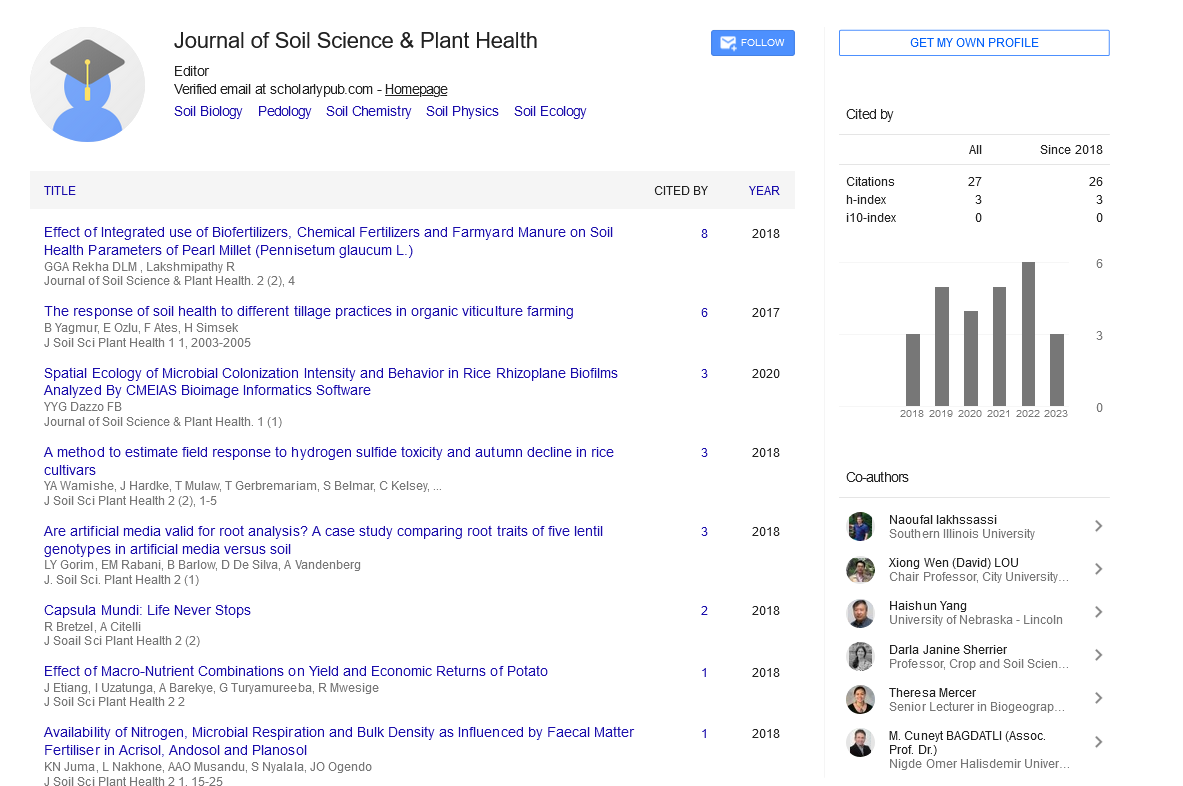Editorial, J Soil Sci Plant Health Vol: 7 Issue: -1
Disease-Suppressive Soils: Nature’s Defense Against Plant Pathogens
Oscar Garcia*
Department of Geology and Soil Science, Sapienza University of Rome, Italy
- *Corresponding Author:
- Oscar Garcia
Department of Geology and Soil Science, Sapienza University of Rome, Italy
E-mail: oscar948@gmail.com
Received: 01-Feb-2025, Manuscript No. Jsph-25-170165; Editor assigned: 4-Feb-2025, Pre-QC No. Jsph-25-170165 (PQ); Reviewed: 18-Feb-2025, QC No. Jsph-25-170165; Revised: 25-Feb-2025, Manuscript No. Jsph-25- 170165 (R); Published: 28-Feb-2025, DOI: 10.4172/jsph.1000210
Citation: Oscar G (2025) Disease-Suppressive Soils: Natureâ??s Defense Against Plant Pathogens. J Soil Sci Plant Health 7: 210
Introduction
Disease-suppressive soils are a fascinating and valuable natural phenomenon in which soil environments inhibit the growth or activity of plant pathogens, thereby reducing the incidence or severity of plant diseases. Unlike soils that require chemical intervention to manage pests and diseases, suppressive soils naturally protect crops through complex interactions between soil microorganisms, organic matter, and plant roots. These soils can significantly enhance plant health and reduce dependence on synthetic pesticides and fungicides [1]. Understanding and harnessing the mechanisms of disease-suppressive soils is vital for promoting sustainable agriculture and improving food security [2].
Discussion
Disease-suppressive soils can be broadly classified into two types: general suppression and specific suppression.
General suppression is attributed to the overall microbial activity in the soil. In highly biologically active soils, diverse microbial communities compete with pathogens for nutrients and space, making it difficult for harmful organisms to establish or cause damage. This form of suppression is non-specific and broadly effective against many pathogens. It is influenced by factors such as soil organic matter content, moisture, pH, and crop rotation [3].
Specific suppression, on the other hand, involves targeted interactions between certain beneficial microbes and specific plant pathogens. In these cases, particular strains of bacteria or fungi inhibit the growth or activity of a specific disease-causing organism through mechanisms like antibiotic production, parasitism, or induced systemic resistance in plants. For example, soils that suppress Fusarium wilt often contain high populations of antagonistic Pseudomonas or Trichoderma species, which produce antimicrobial compounds that directly inhibit the pathogen.
The microbial diversity and abundance in suppressive soils are critical. Beneficial microbes such as Bacillus, Streptomyces, Pseudomonas, and mycorrhizal fungi play major roles in maintaining a balanced soil microbiome that can outcompete or antagonize harmful pathogens [4]. These beneficial organisms can also stimulate plant immune responses, further enhancing resistance to diseases.
Several agricultural practices can help build or maintain disease-suppressive soils. These include the application of compost and organic amendments, reduced tillage, crop rotation, cover cropping, and the use of microbial inoculants. Organic matter inputs, in particular, fuel microbial activity and diversity, contributing to a more resilient and disease-resistant soil ecosystem [5].
However, the ability to develop suppressive soils is not uniform and depends on local conditions such as soil type, climate, and cropping history. Research is ongoing to better understand the microbiological and environmental factors that lead to disease suppression. Advanced tools like metagenomics and soil microbiome analysis are helping scientists identify key organisms and interactions responsible for suppressiveness.
Conclusion
Disease-suppressive soils offer a natural and sustainable approach to plant disease management. By harnessing the power of beneficial soil microbes, farmers can reduce reliance on chemical pesticides, enhance crop productivity, and promote long-term soil health. Although not all soils are inherently suppressive, agricultural practices can be adapted to encourage suppressiveness over time. As global agriculture faces increasing challenges from climate change and pesticide resistance, disease-suppressive soils represent a promising strategy for building resilient and eco-friendly farming systems.
References
- https://library.oapen.org/handle/20.500.12657/38090
- Daipha P (2001). The intellectual and social organization of ASA 1990-1997: Exploring the interface between the discipline of sociology and its practitioners. Social. 32: 73-90.
- Da Silva FC, Vieira MB (2011). Books and canon building in sociology: The case of mind, self, and society. J Class Social. 11: 356-377.
- Diamond L (2006). Seymour Martin Lipset. 1959. Some social requisites of democracy: Economic development and political legitimacy. Am Polit Sci Rev. 53: 69-105.
- Gill TM (2013). Why Mills, not Gouldner? Selective history and differential commemoration in sociology. The American Sociologist. 44: 96-115.
Indexed at, Google Scholar, Crossref
Indexed at, Google Scholar, Crossref
 Spanish
Spanish  Chinese
Chinese  Russian
Russian  German
German  French
French  Japanese
Japanese  Portuguese
Portuguese  Hindi
Hindi 